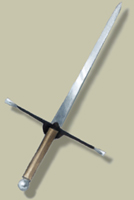|
Forging Guide: Page Four
The Forge
 The
forge is used to shape the head or blade of a weapon. Successful
use of the forge is dependent upon one of the character's weapon-group
forging skills. In order to activate the forge a character needs
to hold a scribed raw material in their left hand and a forging-hammer
in their right hand and then GET TONGS. When a forge is
not being used, a pair of mithril tongs should be visible on the
anvil in each forging chamber. The
forge is used to shape the head or blade of a weapon. Successful
use of the forge is dependent upon one of the character's weapon-group
forging skills. In order to activate the forge a character needs
to hold a scribed raw material in their left hand and a forging-hammer
in their right hand and then GET TONGS. When a forge is
not being used, a pair of mithril tongs should be visible on the
anvil in each forging chamber.
Forges are available within forging workshops, which must be rented
in order to use. When a character's rental time is expired, the
tongs will not be usable.
Before forging, you must fill the tempering trough with a liquid
appropriate for quenching the material that is being worked in the
forge. To use the forge a character must be in good enough health
to operate it, must be wearing a crafting apron, must be holding
the raw weapon material - which has been scribed - in his or her
left hand, and must be holding a forging hammer in his or her right
hand.
The more magical a material is used, the longer it will take to
forge it. Magical materials are also more difficult to forge, and
may require more skill on the part of the character.
Forging a weapon head usually requires multiple sessions. Once
the weapon head is finished, a character's level of success is dependant
on their health, forging skill, strength, constitution and discipline
bonuses, the material difficulty, the amount of material forged,
their profession and race, and a random element.
Having significantly more skill in forging another type of weapon
can prove helpful when forging any type of weapon up to a certain
point of skill. So those characters who have a great deal of skill
in forging brawling weapons, for instance, will have an easier time
forging edged weapons, than someone with no skill in forging weapons
at all.
Successfully using the forge on a material will result in a rough
weapon part, however, if a failure occurs, the material will need
to be scribed again before the forge may be used again. Extraordinary
failures will destroy the material altogether. If there is no liquid
in the tempering trough when the forging session reaches its conclusion,
the session will be aborted and the material will need to be worked
again.
|



 The
forge is used to shape the head or blade of a weapon. Successful
use of the forge is dependent upon one of the character's weapon-group
forging skills. In order to activate the forge a character needs
to hold a scribed raw material in their left hand and a forging-hammer
in their right hand and then GET TONGS. When a forge is
not being used, a pair of mithril tongs should be visible on the
anvil in each forging chamber.
The
forge is used to shape the head or blade of a weapon. Successful
use of the forge is dependent upon one of the character's weapon-group
forging skills. In order to activate the forge a character needs
to hold a scribed raw material in their left hand and a forging-hammer
in their right hand and then GET TONGS. When a forge is
not being used, a pair of mithril tongs should be visible on the
anvil in each forging chamber.